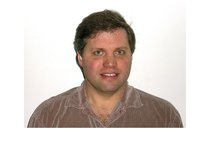Oral history interview with Edwin R. Chapman
- 2005-Dec-05 – 2005-Dec-07
Edwin R. Chapman grew up in Bellingham, Washington, the youngest of four children. His father taught drafting and shop in high school, and his mother stayed at home to raise the children. From an early age Chapman was interested in science, especially in chemistry. He had chemistry sets and a buddy whose father was a pharmacist and who had access to recipes and chemicals; as a result, Chapman set his room on fire several times. His parents were devout Lutherans, but Chapman found religion "didn't make sense" even then. His maternal grandmother came from Romania and had thirteen children; his grandfather came also from Eastern Europe, but it is not clear from exactly where. The thirteen children all had large families, so Chapman has dozens of cousins. Chapman recalls his education in the Bellingham public schools as being unusual and very good, though not especially challenging. He was interested in marine biology, rock collecting, and taking things apart. His father worked construction during summers, and he taught Chapman to do many things around the house. The elder Chapman built a wood lathe, now sixty-one years old, and the two still work together with it. Following, as Chapman says, the path of least resistance, he decided to go to college, and for the same reason he applied to his hometown college, Western Washington University. He discovered there the joy of academic hard work in an organic chemistry class taught by Donald Pavia, whom he considers the best lecturer he has ever encountered. He recently went back to Western Washington University to give a talk and was grateful to show his professors how well he had done because of them. Although the school's emphasis was on classroom teaching, Chapman did his first lab research in the lab of Donald Schwemmin, whom he also remembers fondly. He was yard man at a rental store to support himself during college. For two years after graduation, still not sure what he wanted to do, Chapman worked as a lab technician, designing HIV assays, at Genetic Systems in Seattle. Not wanting to "dead end" there, he realized he needed a PhD , so again "following the path of least resistance" he attended the University of Washington, working in Daniel Storm's lab. Fascinated by the workings of the brain, he decided on pharmacology. Wanting to continue his neuroscience studies, he accepted a Howard Hughes Medical Institute award for a postdoctoral fellowship at Yale in the lab of Reinhard Jahn. Himself a sociable man, Chapman found there people with whom to enjoy talking science and to collaborate. Chapman here compares Jahn's mentoring style and lab management with his own; he then discusses competition and collaboration in science; publishing; his own advice to students. After four years Chapman accepted a position at the University of Wisconsin, Madison, where he is now a full professor. He discusses his funding history and explains how he set up and manages his lab. He goes on to talk about funding in general; writing grants; peer review system; his professional duties; his current research on membrane fusion, synaptic transmission, and neurotoxins; tenure; teaching and travel commitments; educating people in science. He talks about his Chinese students and his impressions of China, and about foreign students in general. His fascination with the brain has resulted in a practical application: his obsession with listening to music on "high-end audio;" this he explains as changing the brain by training it. Chapman describes his future research in the relationship between presynaptic function and behavior and memory; and practical applications of his work, including his collaboration with Meyer Jackson; his view of the qualities of a good scientist; and his professional and personal goals.
Access this interview
By request 1 PDF Transcript File and 10 Audio Recording Files
Fill out a brief form to receive immediate access to these files.
If you have any questions about transcripts, recordings, or usage permissions, contact the Center for Oral History at oralhistory@sciencehistory.org.









